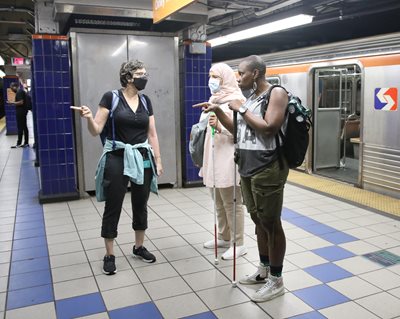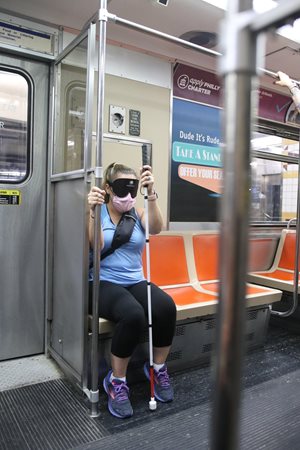The Blindness and Low Vision Studies (BLVS) department at Salus engaged in a subway travel lesson this summer as a part of its Orientation and Mobility (O&M) Techniques course. We sat down with Suha Almusa O&M ‘22 to learn more about navigating subway travel as an individual with visual impairment.
 Q: Why are O&M skills important to have while navigating subway travel as a person with visual impairments?
Q: Why are O&M skills important to have while navigating subway travel as a person with visual impairments?
A: Orientation and mobility skills will help someone with visual impairment have an effective, safe movement in the environment. These skills support people with visual impairment when traveling in the subways or on trains, finding the train doors and boarding, knowing where the seating is, and navigating any barriers that require sensory awareness to gather information by smelling, hearing, touching, and residual vision of the individual with low vision. Moreover, having good white cane techniques to locate objects, preview the surface, clear their way from any obstacles, or know if they reached the stairs or the tactile warning strip beside the train. Orientation and mobility skills also help the person with visual impairment know how a human guide aids while traveling if needed.
Q. What are some key techniques for people with visual impairments who regularly travel on the subway?
A:
A person with visual impairment should never move their feet before sweeping their cane and ensuring where their feet are going.
Be careful to not step over the warning step as there is a drop-off; it is important just to know the starting of the warning strip.
People with visual impairments use the upper protective technique. They have to trail the train to enter when they can’t locate the train door.
Q: How does the Philadelphia subway system differ from other subways you have navigated? Do these differences make navigation easier or more difficult?
A: I have used Boston subways, and they seem the same. Still, I noticed most subways ensure having a warning step, but I feel subways could improve accessibility by having a loud audio announcement when approaching the destination. Hence, a blind traveler knows that he has reached the wanted station or destination.
 Q: What do you hope these skills bring to the people back in your home country of Saudi Arabia?
Q: What do you hope these skills bring to the people back in your home country of Saudi Arabia?
A: From my point of view, orientation and mobility skills provide independence, confidence and high self-esteem that will affect their success in being included in society, being employed and enjoying their leisure time.
Q. Why do you think it is important for O&M specialists to know subway travel techniques?
A: An orientation and mobility specialist should be able to train a person with visual impairment to navigate in different environments: indoors and outdoors, crossing streets, and using public transportation. Because what we are providing is meeting all the daily travels that a person with visual impairment needs to do. An individual might need to use a train or a bus to reach their university or work, and to achieve that, they need to know how to navigate subways safely and efficiently to get to their destination. Not having a human guide will not stop an individual from being at work or the shopping mall, which means traveling with a white cane will unlock the world of independence.